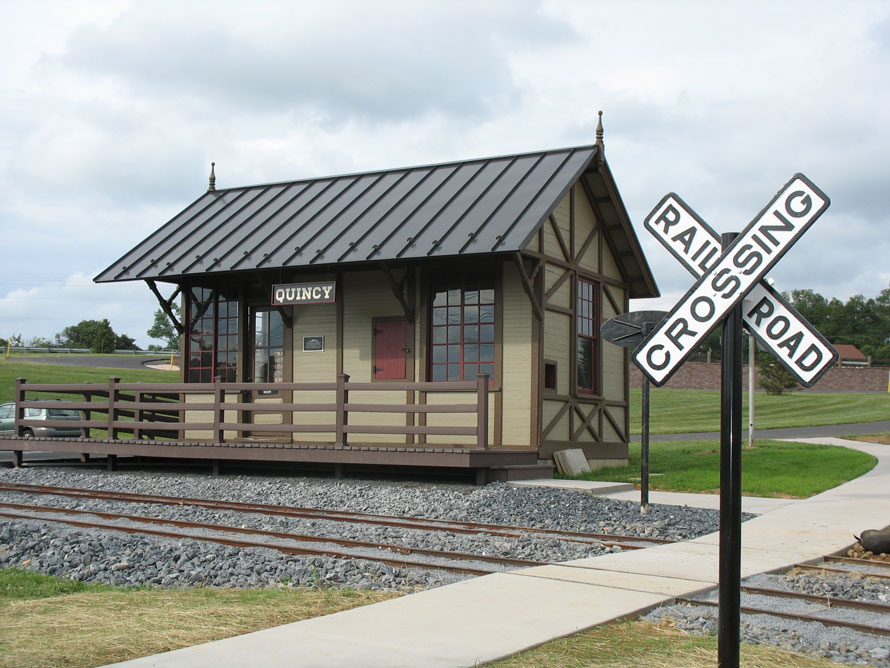
(James Fouchard Photo)
Back in an earlier era of railroading, it was not uncommon to move station buildings from one location to another. It may have been a short procedure necessitated by work on a new track alignment. Or, if a new, larger station was being built in a town, the smaller existing structure might be loaded on a flat car and transported by rail to a new town. Temporary stations were sometimes built specifically to be moved from site to site as needed during construction. Even to this day, it is not uncommon to see depots vacated by the railroads moved from the right-of-way to new sites for historical preservation as museums, or for other commercial uses.
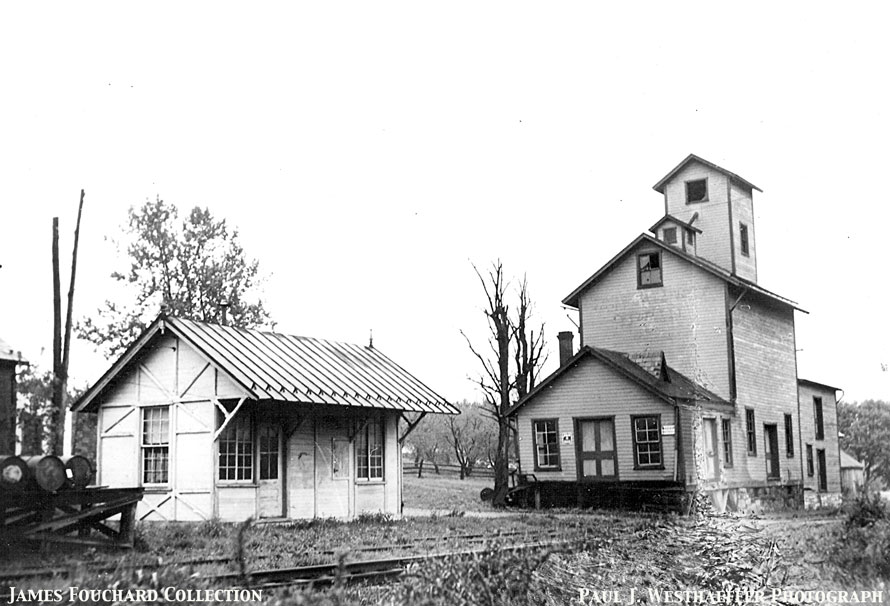
(Paul Westhaeffer Photo- James Fouchard Collection)
The small Victorian station originally located in Quincy, Pennsylvania may be a contender for the record number of moves, but this time all in the interest of historical rail preservation.
Located on the Waynesboro Branch of the Cumberland Valley Railroad, originally the Mont Alto RR, Quincy was a small town surrounded by orchards and farms, as well as home to the Quincy Engine Company, a small, late 19th century gasoline engine manufacturer. To serve these customers the railroad built a long siding with a combination grain elevator/ freight house in the village, and later a small passenger/express office. This station was one of several small depots the CVRR built during the 1880s-90s in lesser towns, including Fayetteville, Middlesex, Berkley and Washington Street in Mechanicsburg. They were patterned on the lines of a Pennsylvania RR standard design first used for its waiting shelters beginning in the 1880s, following the “stick-style” of architecture popular at that time. It was sometimes referred to as Queen Anne or Eastlake, with its prominent half-timbered framing on the exterior walls and elaborately turned spindle roof brackets and finials. A remarkably close cousin to Quincy Station served as the original PRR depot in St. Davids, Pennsylvania.
The CVRR was eventually absorbed into the Pennsylvania Railroad system in 1918. Quincy Station continued to serve as a ticket/express office and block station during the 1920s, with telegraph and telephone service. But as the Depression hit the railroad, passenger service was cutback and eventually eliminated in 1933 on the branch line. The small Station was closed, and sat alongside the grain elevator through the decades, another weather-beaten deserted structure along the rail line.
The damage from massive flooding by Hurricane Agnes caused the branchline to shut down in 1972, and by 1979 the tracks were removed from Quincy. The Station was purchased by Janet Knouse of Knouse Fruitlands (later known as Lucky Leaf). The company pushed the small depot onto railroad ties off the railroad property onto their orchard land next to the old grain elevator. This would be the first of many journeys for the little Station, albeit a short one.
Here I am, sitting in the back seat of a car with a famous film and television star whom I just met, driving down little country roads in search of an old depot!
Quincy Station entered my life in 1982, as I started a new summer job as Set Designer at the famed Totem Pole Playhouse, located in Caledonia State Park and operated by William “Bill” Putch. I had previously interviewed for the job with Mr. Putch at his home in the park. When discussing the theater’s operation, Bill mentioned that he was currently building a railroad-themed restaurant on a site within the park along US Route 30. When I mentioned that I had a long-time interest in railroad history and collecting artifacts, he drove me over to the restaurant site where they were assembling a string of vintage rail cars and building a replica station, not unlike the Victoria Station chain of restaurants.
On my first day on the job in May, Bill invited me up to dinner at his house that evening with his wife, noted actress Jean Stapleton. After meeting Jean and enjoying a great dinner we sat around the table on their porch overlooking the wooded parkland. Bill mentioned that he had heard there was a small abandoned railroad station located somewhere in the nearby Quincy area that he thought might be a great addition to his new restaurant. I agreed that he should pursue locating it and he jumped up and said “Let’s go then!” So the three of us, Bill, Jean and I, climbed into his car and set off down the road in search of the station. As we turned off Route 30, I thought: “Here I am, sitting in the back seat of a car with a famous film and television star whom I just met, driving down little country roads in search of an old depot!”
We continued down Rt. 997, which paralleled the route of the branch line, through Mont Alto and into Quincy, pulling off every side road that looked promising. But as then sun slowly set in the valley we failed to find any trace of the station and headed back to Caledonia.
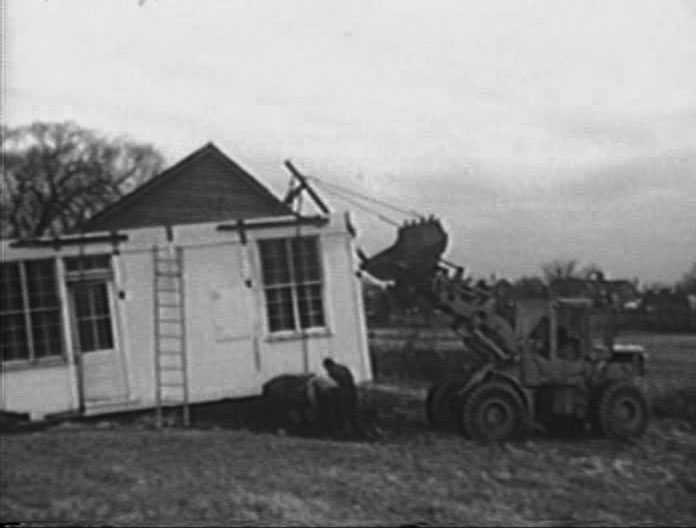
(James Fouchard Collection)
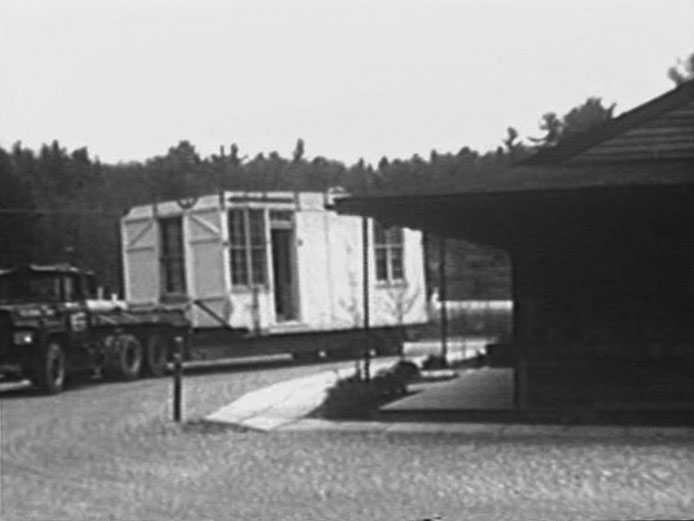
(James Fouchard Collection)
Later that summer I showed Bill a photo I had found of Quincy Station in Paul Westhaeffer’s book “The Cumberland Valley Railroad” and, after further research, Putch located the Quincy Station and made arrangements with Janet Knouse to purchase the building. Mrs. Knouse was eager to see the station preserved, particularly in a railroad motif. For its second move the station was cut up and transported in three sections by Fayetteville Contractors to the Caledonia Station Restaurant site during the fall of 1982. Extensive rebuilding and restoration was done on the structure, including the installation of a new standing seam metal roof. The Quincy Station was used at the restaurant as a small museum piece to be viewed by diners. When I returned to Totem Pole the next summer season, it was love at first site when I visited the restored station. This little gem of a Victorian building, with its big lathe-turned roof brackets and bevel-edged trims was quite an eye-catcher which appealed to me both as a designer and devotee of rail history and architecture.
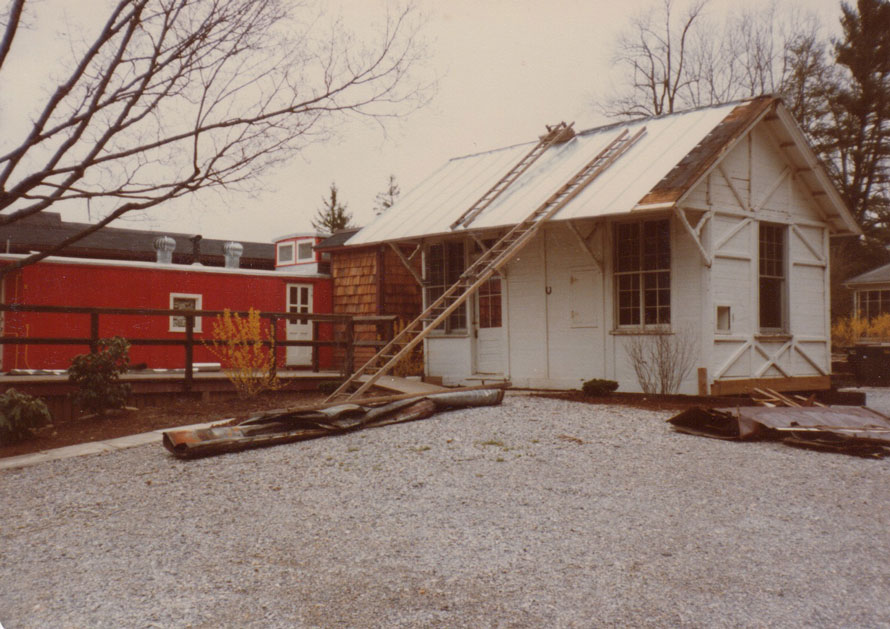
(James Fouchard Collection)
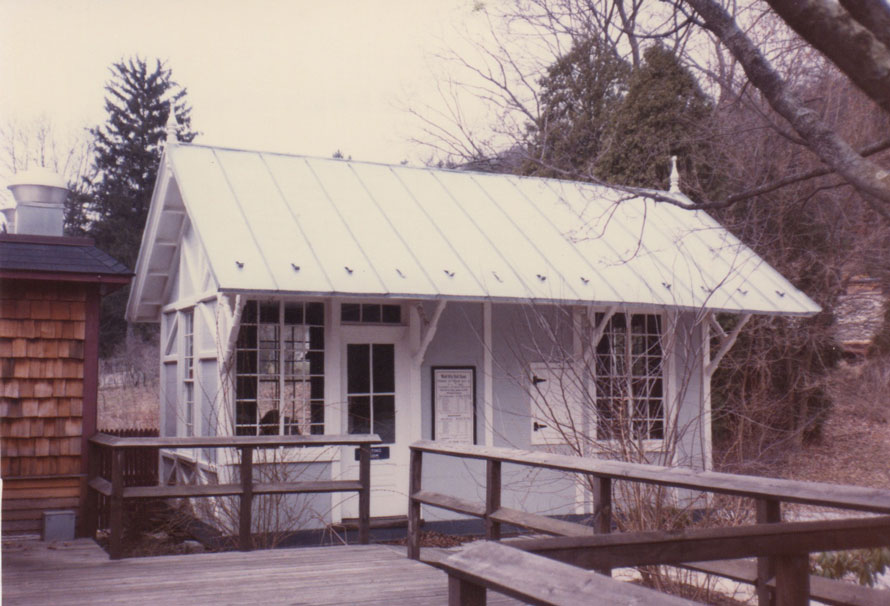
(James Fouchard Photo)
In the fall of 1983, while directing his wife, Jean Stapleton, in a production of “The Show-Off” in Syracuse, New York, Mr. Putch suffered a heart attack and died. Ms. Stapleton continued to operate the restaurant, as well as the nearby Totem Pole Playhouse for the 1984 season. The restaurant closed in 1985 and was put up for sale. I contacted Jean then as to whether she would consider selling the station to me.
I purchased the Station in 1987 with the intent to preserve the historic railroad structure, rather than it winding up bull-dozed over, a fate so much of our rail heritage has suffered. I made arrangements with the new owner of the restaurant to leave the Station on-site until I found a suitable location to move the building to.
By 1989 the restaurant had closed again and I scrambled to find another site for the Station. Thanks to the generosity of Carl Schurr and Wil Love of Totem Pole Playhouse, I was able to relocate the Station onto a property owned by the company. I contracted Crouse House Movers of Littlestown, Pennsylvania, to handle the short move from the restaurant site. For the station’s third move they jacked the building up to haul it in one piece on a low-boy flatbed tractor-trailer to its next location. There they set it up on a bed of railroad ties to facilitate its eventual move to a more permanent home. In the meantime, the little depot served as a storage building for various prop furniture owned by the theater.
While searching for that new home for the depot, I continued to research the history of the station, and contacted Mr. Paul Westhaeffer, author of “The History of the Cumberland Valley Railroad,” for further information. He provided me with some details regarding original color schemes and background information of the operation of the CVRR, as well as an original print of the photograph he took of the of Quincy Station in 1948 which was was featured in the book.
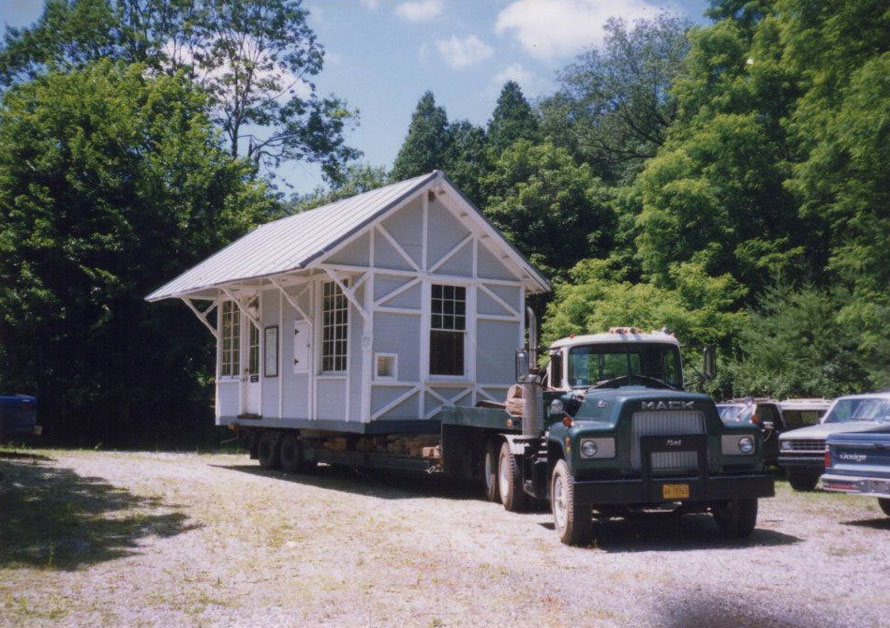
(James Fouchard Photo)
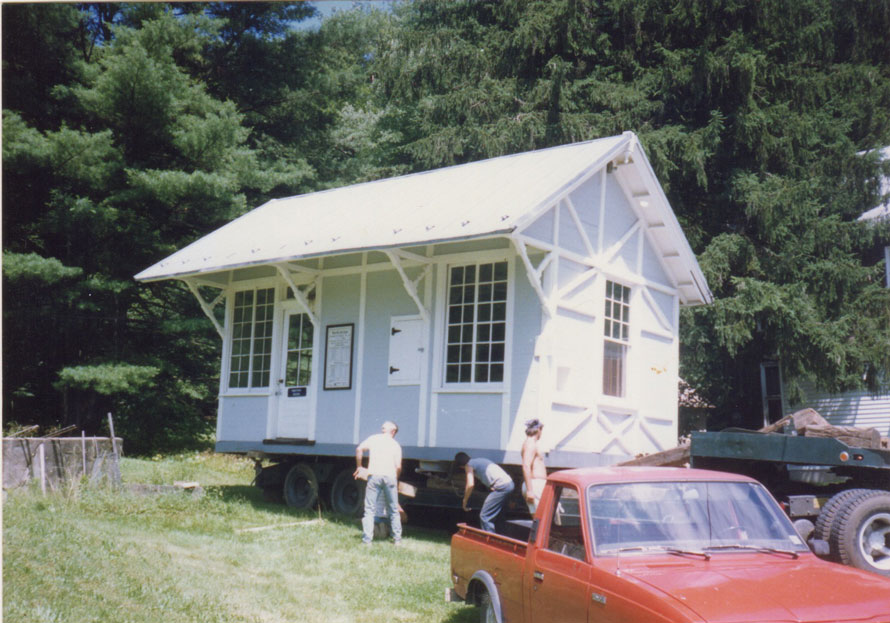
(James Fouchard Photo)
In 2004, Mr. Greg Cook, Chairman of the Guilford Township Supervisors contacted me concerning their interest in relocating Quincy Station to Norlo Park to become a part of the historic rail equipment and structures that were being assembled there. The Park was developed as a community activity area from an old farm, featuring picnic areas, sports fields, walking and bike trails, and a dog-walk park. The Township Supervisors also placed an emphasis on historic preservation, beautifully restoring the original 19th century farmhouse, barn and outbuildings for use as offices, reception, dining and meeting facilities to serve the community. At the time I was still trying to find a site on my own, but we kept in touch over the next few years.
In the summer 2008 Mr. Cook and I began negotiations for the acquisition of the station by Guilford Township. He had previously taken me on a tour of the farm buildings already restored here at the park and I was impressed with the craftsmanship and the dedication to preserve these historical structures onsite there. I also was happy to know that the Waynesboro Branchline that the station was a part of at one time, originally ran right through the farm.
In preparation for Quincy’s fourth move, workmen from Guilford Township partially dismantled the building on site and the structure was moved down Route 30 to Norlo Park, using a large crane and flatbed tractor trailer provided by Dave’s Truck Repair of Chambersburg. Mike Ferguson and the Township crew then reassembled the Station on a new foundation alongside the old railroad right-of-way and beautifully restored the vintage building inside and out. A new standing seam metal roof was installed along with replacements for other pieces that had deteriorated over the years.
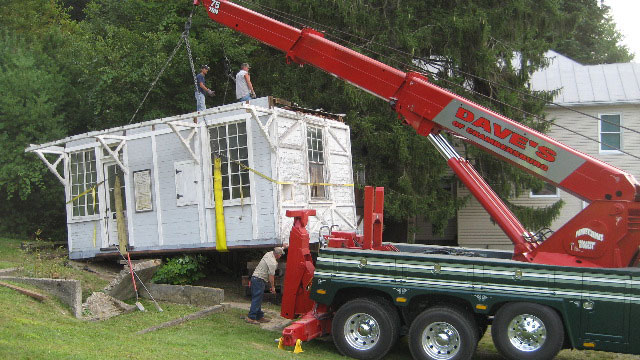
(James Fouchard Collection)
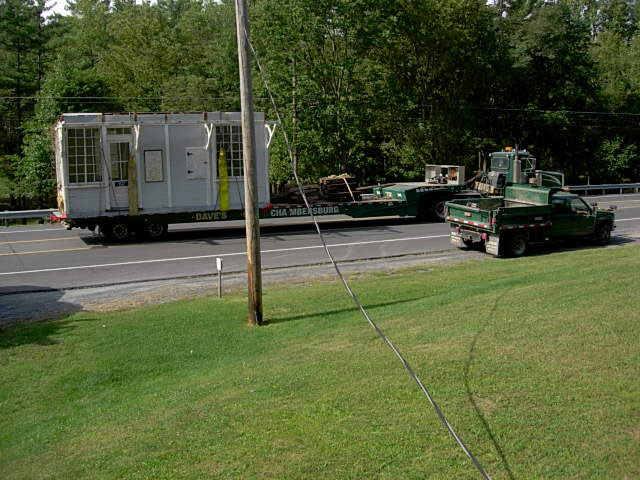
(James Fouchard Collection)
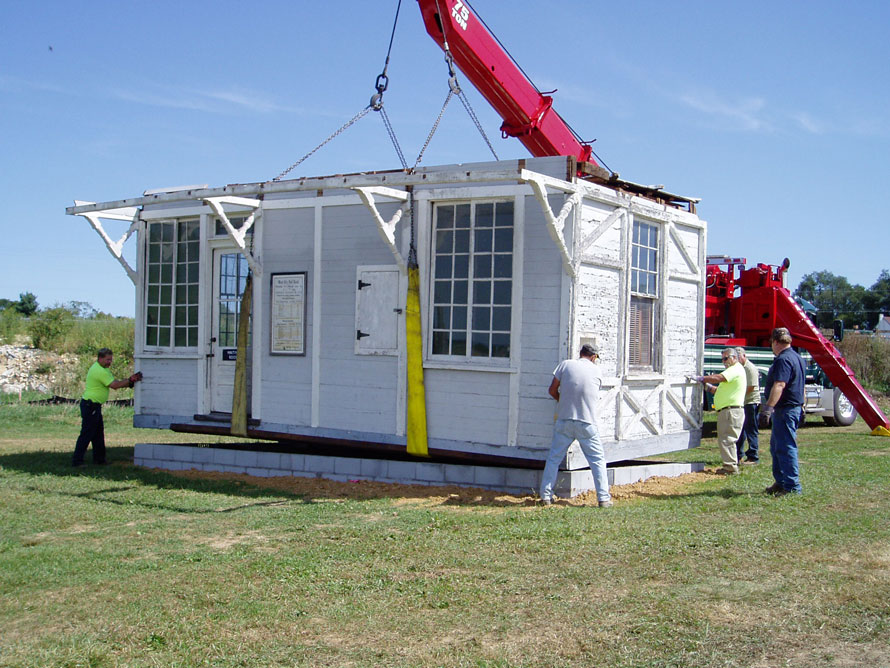
(James Fouchard Collection)
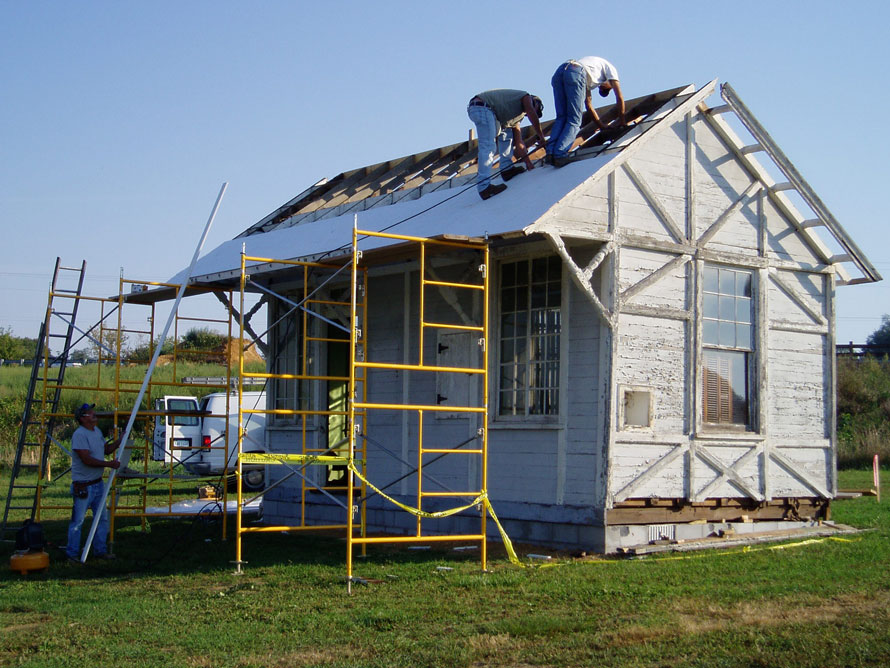
(James Fouchard Collection)
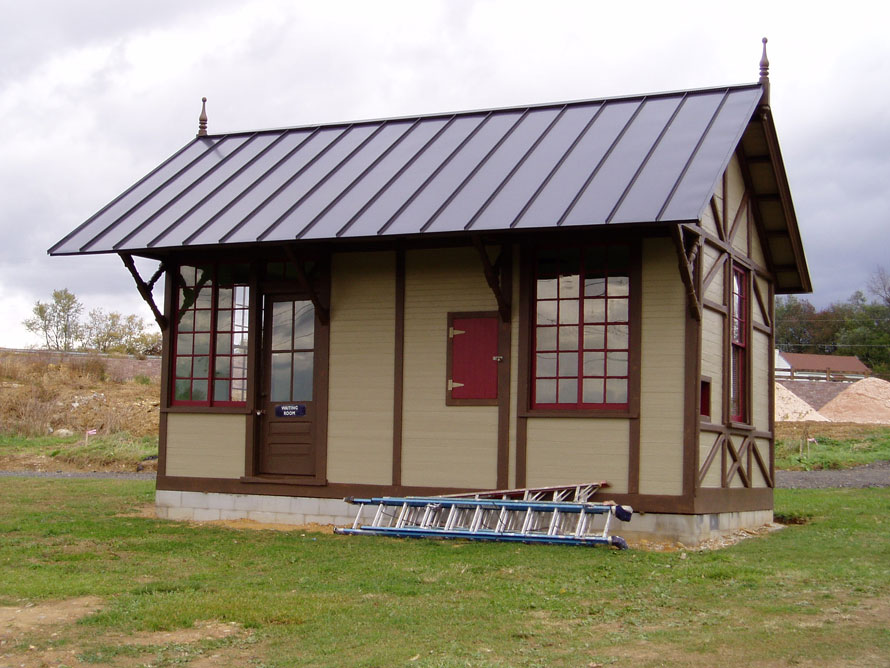
(James Fouchard Collection)
The original color scheme of the exterior of the building was recreated, under my supervision, with paint samples I had obtained that were reproduced by the Pennsylvania Railroad Technical and Historical Society. I also assisted by assembling and decorating the interior with furnishings and railroad artifacts, some of which I had been collecting over the years to display in the Station, recreating its life in active use by the railroad,
The restored interior recreates the atmosphere of a working railroad station at the turn of the last century. The waiting room has a sturdy wooden bench and pot-bellied stove for use by waiting passengers, and the Train Bulletin Board on the wall informs them of train arrivals and departures. A small postal station, complete with brass lock-boxes provided village citizens with a place to send and receive mail.
On the other side of the partition wall, the agent’s office is fitted out with both telephone and telegraph equipment, important communication devices for rail operations. Hand cart and scales also are provided for use in receiving and dispatching freight and express shipments. The agents’s office also contained two small doors that connected to the outside of the structure. The larger of the two was in the front wall of the depot and served as a cabinet for the dispatcher’s phone connecting the station to the office in Chambersburg, as well as other stations on the branch. When the station was closed, the phone was placed in this cabinet so that train crews could have access to it to communicate with the train dispatcher. Locked mailbags may also have been placed inside this door for pickup when the station was closed. The other small door was located on the side wall near the front of the station for depositing waybills and other railroad paperwork.
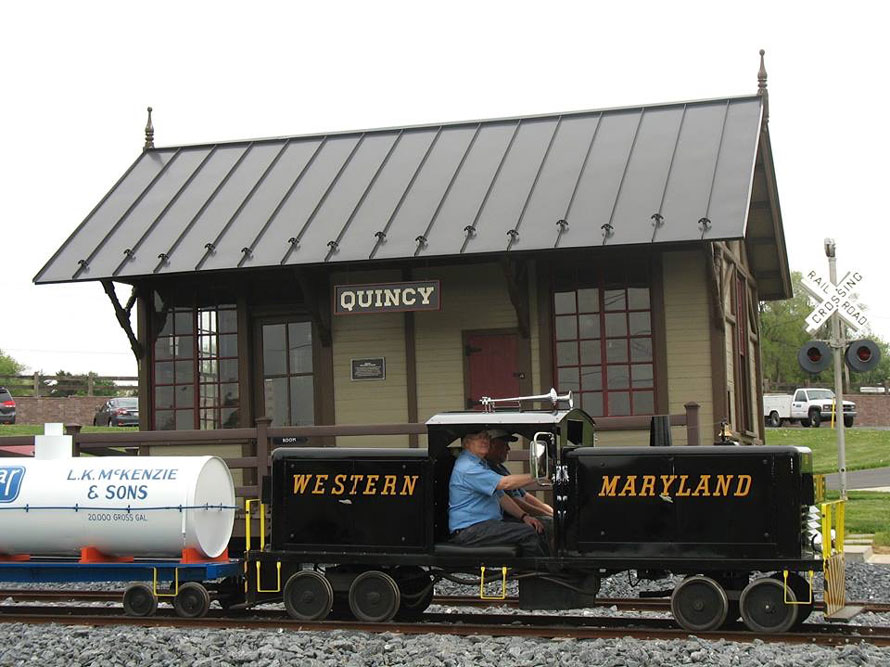
(James Fouchard Collection)
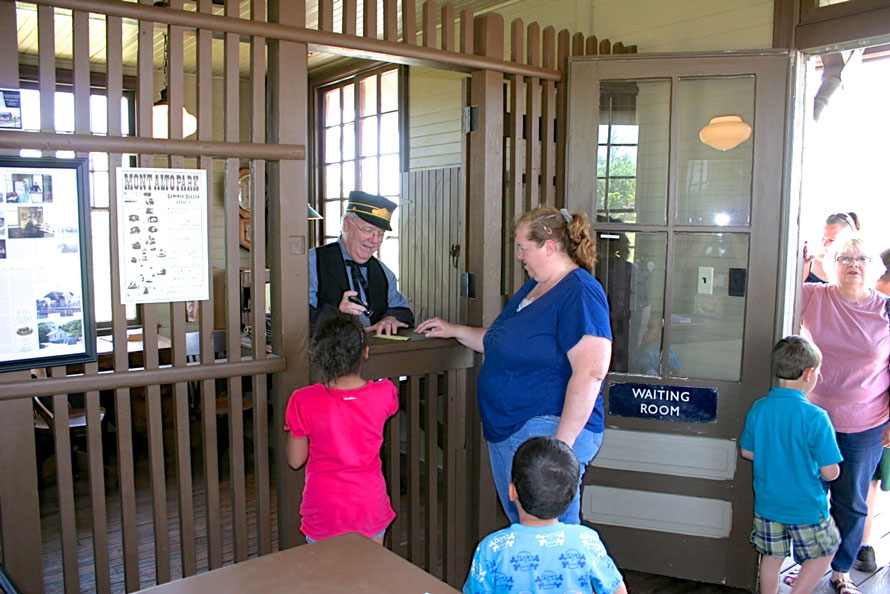
(Kirk Beseiger Photo)
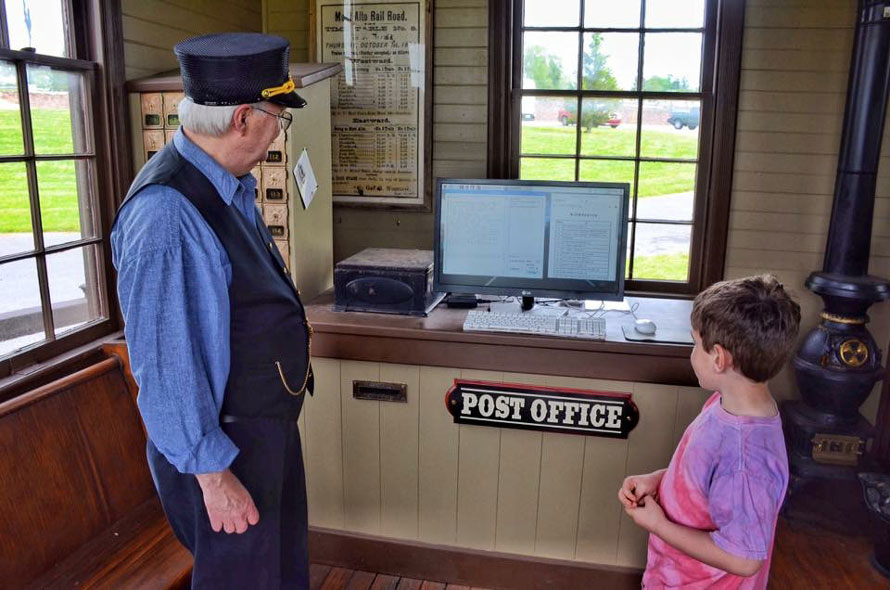
(Jim Stanton Photo)
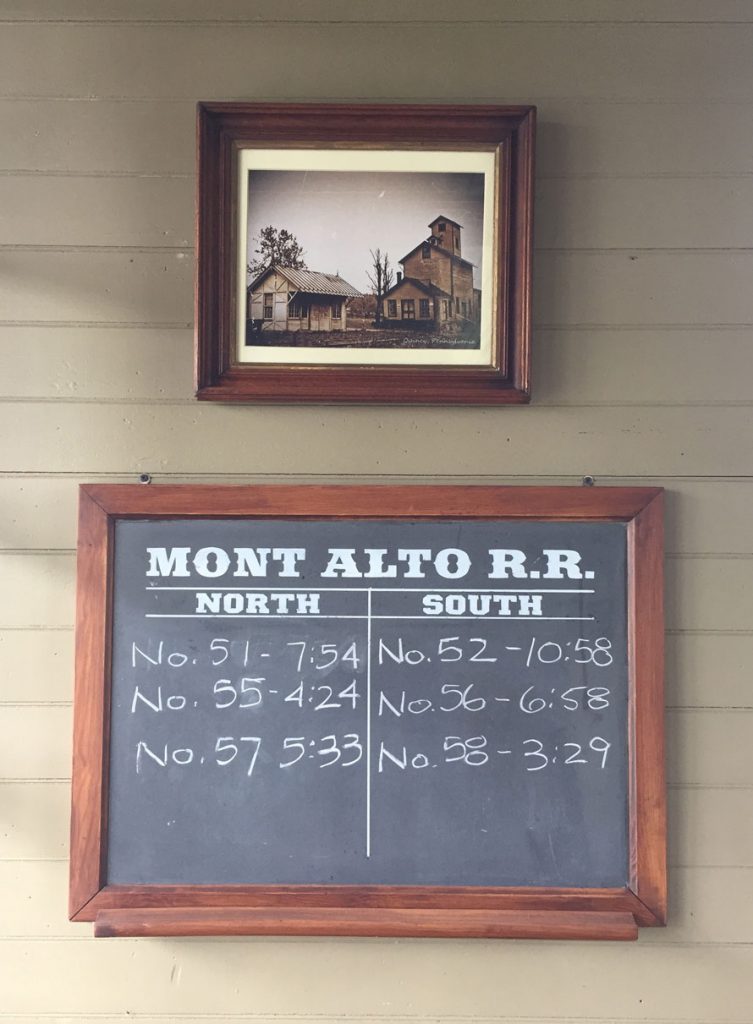
(James Fouchard Photo)
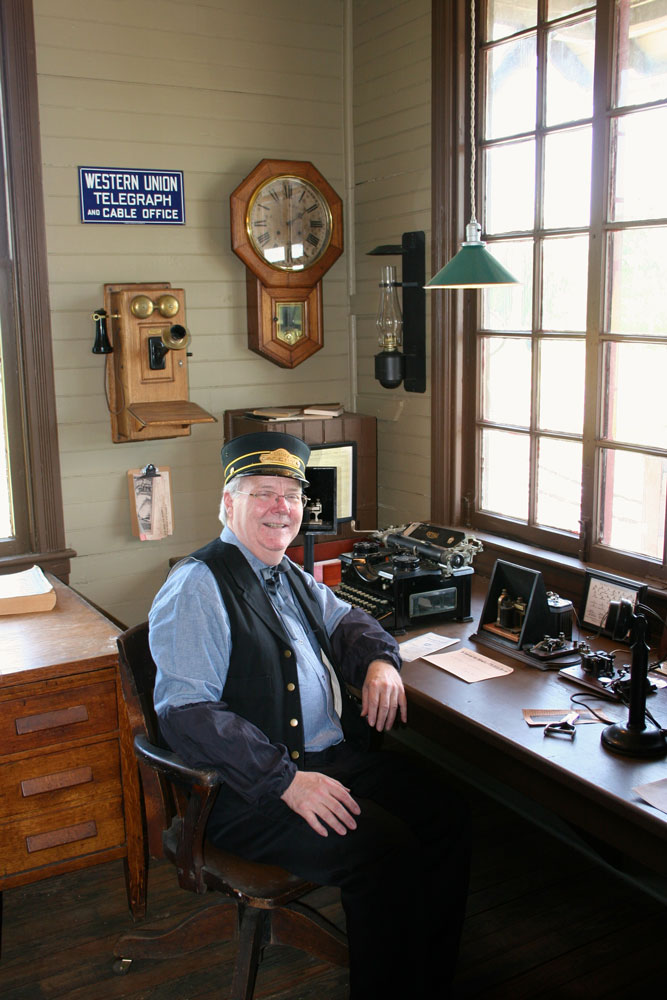
(Kirk Besecker Photo)
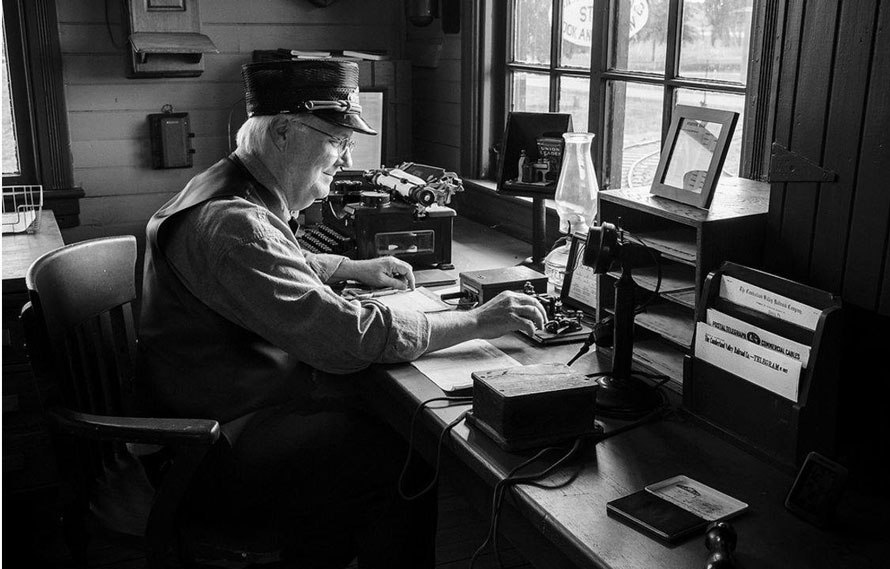
(Jim Stanton Photo)
In July 2013, the Quincy Station was dedicated as part of a Railroad Heritage Area at Norlo Park, which also includes an operating miniature train donated by the late Arnold McKenzie, a Western Maryland RR Section House, two ex-PRR cabooses and a rare vinegar car. Volunteers from the Cumberland Valley Chapter of the National Railway Historical Society operate the train ride on Saturdays during the summer, and I serve as station agent/museum guide at the Station. I stamp passengers tickets with an authentic railroad validator and, in addition, we have a live telegraph operating courtesy of an internet connection to MorseKOB.
The installation of Quincy Station at Norlo Park is the culmination of over thirty years of effort by a variety of individuals and organizations to preserve this rare and important piece of Cumberland Valley Railroad history and to share it with all. Each of the little station’s journeys through these years have contributed to this end.
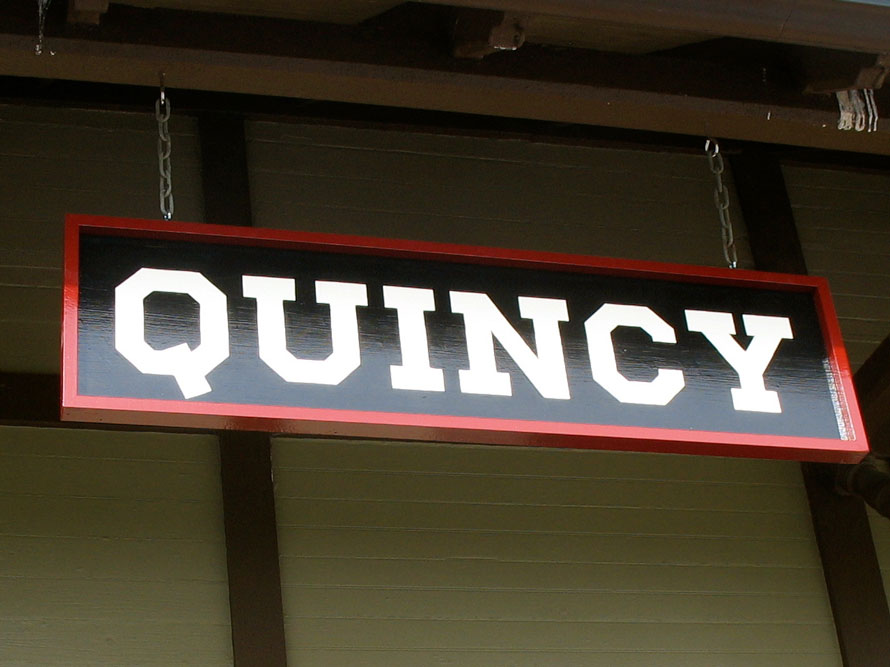
(James Fouchard Photo)
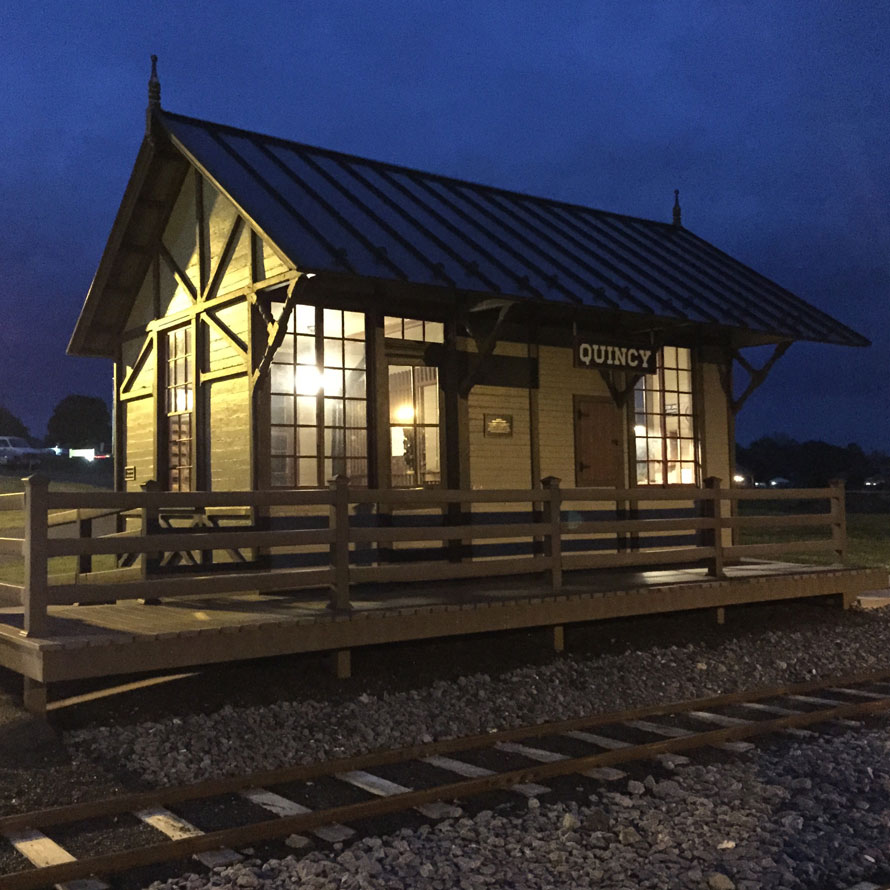
(James Fouchard Photo)
For More Information, see http://www.jamesfouchard.com/quincy/station/index.html
James Fouchard – Photographs and text Copyright 2019
I will say that I am glad that this place was not demolished.
I certainly am, too. And grateful to Janet Knouse and Bill Putch for also saving the Station before myself.
What a great story! So glad you saved it, as you say many are lost. At the Railroad Museum of New England the Yard Master building from Fall River Mass. was saved and moved. Not as much inside as you have but we have a station and like all things like this its a work in progress. You did a wonderful thing that will be enjoyed by many for many years.
Thanks John, hope to visit your museum someday.
I am a retired railroad employee having worked for the MECRR/B&M/D&H combination. The MEC became Guilford Trans. and evolved from the 3 railroads mentioned above. GTI is now Pan Am (big change for a railroad). After many years I pulled the pin but not before I rose from a clerk to Mgr. Divisons (in the money making dept.) as I used to tell anyone who would listen. I loved working for the railroad and I think probably all things considered would gladly gain employment with a railroad again. Before that I retired from the CG, loved that also. I was in WW2 and my folks signed my enlistment papers because I was only 17, I would enlist again probably. IN GOD WE TRUST